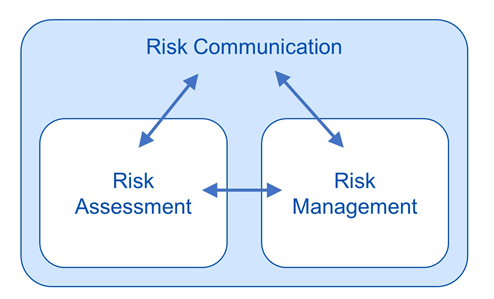How often does the average person calculate a hazard vs. risk? Further, what does risk mean across our everyday decisions?

A lineman may define risk as climbing poles to repair high voltage lines, where a stock broker may define risk in a financial context related to high value trades. The definition of a hazard could vary just as much from person to person, so it is no surprise that risks and hazards can be misunderstood and miscommunicated either unintentionally or intentionally.
A parent may wish to raise alarms of danger by miscommunicating fire risks without actual understanding and the media may wish to miscommunicate risks for the purpose of generating clicks. In addition to hazards and risk, scientific units are often miscommunicated in the media.
A hazard by Merriam-Webster as a noun is a source of danger. OSHA defines a hazard is any source of potential damage, harm or adverse health effects on something or someone. Examples of something that has the potential to cause harm to a human, it could be a downed power line, an uneven surface, a railroad crossing, or a mountain of loose snow primed for an avalanche. Risk by Merriam-Webster as a verb is to expose or incur hazard or danger. OSHA defines a risk as the chance or probability that a person will be harmed or experience an adverse effect if exposed to a hazard. Risk is the likelihood of a hazard causing harm. The prospect of being buried by an avalanche or driving across train tracks might inspire terrible fear in a person, but in reality poses zero risk to the majority of the population. The media has reported on stories that can elicit similar fear through alarmist articles or the use of alarmist language by presenting a hazard without equating it to a risk, and capitalizing on uncontextualized, complicated scientific information.
The recent articles reporting on the use of chlormequat chloride in commercial agriculture are examples of miscommunication of hazard and risk by presenting an incomplete summary of scientific facts, and failing to contextualize risk in a meaningful way.
News outlets reporting on hazards of agricultural uses of chlormequat chloride are based on a study published by members of the Environmental Working Group and the Medical University of South Carolina in February 2024. In the study (Temkin et al), the authors measured the levels of chlormequat in urine of individuals from three geographic regions within the US between 2017 and 2023, as well as the levels of chlormequat in oat and wheat-based products purchased in the US in 2022 and 2023. Temkin, et al. reported the presence of chlormequat in urine samples (96) collected from people in the U.S. with detection frequencies of 69%, 74%, and 90% for samples collected in 2017, 2018-2022, and 2023, respectively. In addition to urine samples, the study authors observed high detection frequencies of chlormequat in oat-based foods.
Temkin et al. describe potential adverse health outcomes associated with chlormequat, observed in pigs, mice, and rats, including impacts on developmental, reproductive, and endocrine systems. Temkin et al. opine that the marked increase in both frequency and concentration of chlormequat detected in US urine samples and chlormequat toxicity data “raise concerns about current exposure levels, and warrant more expansive toxicity testing, food monitoring, and epidemiological studies to assess health effects of chlormequat exposures in humans.” The authors describe chlormequat as an “emerging contaminant with documented evidence of low-dose health effects in animal studies.”
However, Temkin et al. fail to describe a dose-response relationship between chlormequat ingestion, and equate that to a risk of adverse health outcomes in humans. The authors note that “equivocal evidence in the toxicological literature on chlormequat may be due to differences in doses tested and outcomes measured as well as selection of model organism and the sex of laboratory animals.” This statement highlights that different doses in different organisms produce different outcomes, further obscuring correlation between the findings of chlormequat in urine and risk of adverse health outcomes in humans. As with any substance the risk is in the dose, 2 aspirin are advised, a bottle of aspirin is ill-advised.

In 2021, the US EPA published a Human Health Risk Assessment (HHRA) Hazard Characterization and Dose Response on chlormequat that established a reference dose for human consumption without risk of adverse health effects.
According to the 2021 HHRA, chlormequat can be safely ingested at a rate of 0.05mg per kilogram of body weight per day, over the course of a lifetime, without risk of adverse health effects. EPA reference doses are calculated to be protective of the most sensitive populations, and factor in additional conservativism in the form of safety factors.
Chlormequat concentrations in urine from Temkin et al. suggest exposures to chlormequat exist at concentrations several orders of magnitude below the reference dose (RfD) published by the EPA (0.05 mg/kg bw/day), and the acceptable daily intake (ADI) value published by the European Food Safety Authority (0.04 mg/kg bw/day).
Risk in Context
According to the findings in Temkin et al., the median levels of chlormequat in a conventional oat based cereal product were 114µg/Kg. To put this concentration in context, a man that weighs 176lbs (or 80Kg) would have to consume 35Kg or 77lbs of cereal per day just to meet, not exceed, the US EPA reference dose. For a 32lb (or 14.5kg) child, it would take 6.35kg or 14lbs of conventional oat based cereal product per day to reach the EPA RfD. These weights in conventional oat cereal equate to approximately 102 standard boxes of cheerios for a man or 18 boxes for a child, consumed per day, to meet the minimum standard for safety set by the EPA.
Context is critical in enabling people to make risk-based decisions that may or may not drive changes in behavior regarding a hazard. Existence of a hazard does not automatically imply the existence of risk. Just like the hazard of an avalanche poses negligible risk to a person outside the context of skiing on an avalanche prone mountain, oat based cereal products pose similarly negligible risks in the context of normal consumption habits. Conversely, zero risk does not negate the existence of the hazard, avid skiers should be well aware of the hazards associated with their sport, but given how unlikely it is that a 176lb man consumes 77 pounds of cheerios every day, any hazards associated with consumption of cereal grains treated with chlormequat do not need to be top of mind for the typical consumer.
For more information on RHP’s services and contact information, please contact Ashish Jachak, PhD, MBA at ajachak@rhprisk.com, (678) 896-6042, Frank Pagone, PhD, CIH at fpagone@rhprisk.com, (773) 867-6011, or Ben Heckman, MPH, CIH at bheckman@rhprisk.com, (717) 706-3847, and visit rhprisk.com.
